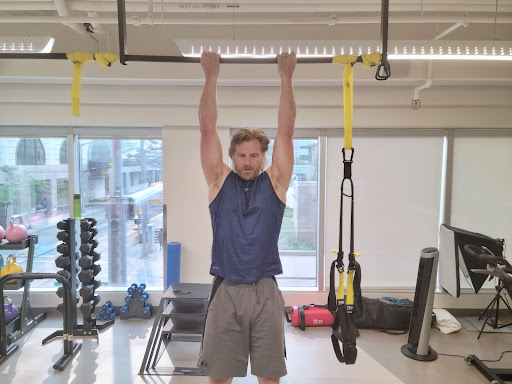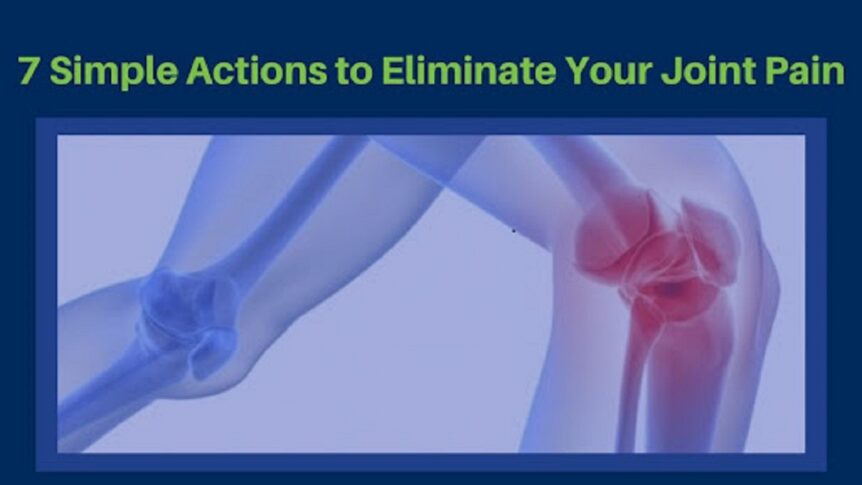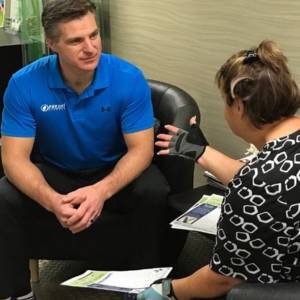Let’s face it. Joint pain sucks.
The pain stops you from feeling healthy, vital, and strong.
Even worse is that fear and stress actually amplify your pain responses.
This creates a downward spiral of fear, stress, and pain that continues to get worse because each component fires up the others.
The great news is that this pain spiral can be stopped, and even reversed.
The best part is that the solution is often very simple. A huge amount of joint pain can be eliminated by simple movements (mobility, soft tissue work, exercises, etc.).
Interestingly, many of these actions don’t even involve the joint that’s bothering you.
Many trainers and medical practitioners don’t fully understand the causes of pain or are too lazy to get to the root of the issue. They end up treating symptoms or prescribing unnecessary medications.
So, when you have pain, I definitely recommend consulting a top-quality sports physiotherapist or another practitioner well versed in functional movement and pain.
This will allow you to be sure of the source of the pain, and determine the next steps.
However, even before that meeting, there’s one key mindset factor you must start believing in.
YOU are the person responsible for resolving your pain on your own.
A physio, doctor, chiro, massage therapist, or trainer can’t heal you.
These people can be facilitators that open the doors that help your body HEAL itself.
Your brain and your body are the most important pieces of the pain management and pain elimination puzzle. If your brain is stuck in self-pity, why is my pain loop, your body will not heal?
YOU must believe you can heal and take consistent daily actions to manage, eliminate, and prevent pain in your body.
This will allow you to take the next steps, including learning to move well and moving how you want…without pain.
BUT… here’s a quick warning:
I’m not a doctor, a physical therapist, or a chiropractor.
I’m a personal trainer, performance coach, and functional movement specialist. But most importantly, I’ve used this knowledge and decades of personal experience to put these actions together because they WORK FOR ME and my clients.
Action 1: See a qualified professional about your joint pain
Pain is your body’s way of saying that something isn’t right. The first step is to get high-quality information about your situation.
Do you have an acute injury (strain, sprain, tear, etc.), or a chronic condition that needs to be managed (i.e. arthritis)? Maybe a seemingly unrelated medical condition that needs attention and is contributing to the pain response?
Keep in mind that physios and medical professionals aren’t gods. Their advice isn’t always correct. However, seeing top practitioners and getting opinions from multiple professionals is a great idea, particularly for serious issues.
Remember – if any professional tells you not to move at all, to give up athletics, or stop exercising completely. I would be highly suspect and get a second opinion right away.
From my experience, unless you’ve broken almost every bone in your body or have had massive invasive surgery, there is almost always a way to keep moving (with appropriate modifications) throughout an injury recovery.
Lack of movement is one of the fastest ways to make almost any injury worse…never mind your overall quality of life.
Action 2: Realize that you don’t need to be “hitting the gym” to “lift weights”
Weightlifting is great.
It can help you build strength, muscles, bone density, and more.
However, weightlifting can also run you headlong into a series of nagging aches and pains.
This includes serious long-term injury when weight training is done poorly.
So what’s the solution?
Simple. Balance (or temporarily replace) weight training with functional movement and bodyweight training.
Old school bodybuilders like Arnold Schwarzenegger started their careers with a few years of bodyweight training.
This is BEFORE they got into weight lifting.
Gymnasts and other athletes often do MOST of their training as bodyweight…and they are crazy fit and strong.
Bodyweight training and functional movement are your most essential physical education. You learn to move your body correctly. It’s about gaining physical literacy and injury-proofing your body.
So, if you’re dealing with pain right now, I encourage you to seriously consider doing much more bodyweight training and reduce or eliminate weight lifting.

Pain-relieving bodyweight training
Action 3: Use the stoplight test for pain – and keep moving
The BIGGEST MISTAKE people make when they are in pain is to stop moving.
They stop moving completely.
This is often made worse by short-sighted medical practitioners that tell people to “avoid exercise” during their recovery.
YES, regular rest and recovery are important.
However, the human body was meant to move and can actually heal itself through movement.
Movement provides blood flow, stimulation, along with massive physical and psychological benefits.
BUT, the wrong type of movement can definitely aggravate your pain
So how do you know what to do?
This is where the stoplight test comes into play.
Use this simple assessment to decide what you should do, and what you should avoid (for now).
Green: The movement or exercise feels good. Keep going.
Yellow: There is some slight discomfort with the movement. But there is no lingering discomfort or pain when you stop the motion.
In this instance, check your form. Getting guidance from a professional movement coach can be helpful here. Since even small variations in technique can be the difference between green, yellow, and red…particularly with an injury situation.
Slowing the motion down and being extra conscious of alignment and technique is also helpful.
Next, check the range of motion. Is there a specific range of motion where you can do the exercise pain-free? If so, spend most of your time in that range.
For example, if your knee hurts when squatting, but only at the bottom, then you can reduce the depth of your squat to stay within the pain-free range. It’s helpful to periodically explore the range of motion and identify when the pain starts, the intensity of the pain, and how it feels. This will help you communicate it to your physio or movement therapist.
Try different joint angles. For example, does the pain go away (or get worse) if you squat with your feet wider, toes turned out slightly, or some other variation?
If discomfort persists but is mild (<5 on a scale of 10), proceed with caution and follow the tips above to minimize discomfort and better “map” the pain response.
Red – The movement hurts. Avoid that movement for now and book an appointment with your physio or movement specialist.
Your goal will be to keep finding green movements to do!
Regardless of your injury, there will always be a movement you can do without pain. It’s also important to remember that if you have a constant level of “systemic pain”, and exercising doesn’t make it worse, then keep exercising!
I use this with clients who have arthritis or conditions such as no cartilage in their knees. There is usually a base level of pain all the time.
Establish a number for this baseline (i.e. 3 out of 10), and if a particular movement puts it to 5 and above, try something else. If it’s 4 or lower, then keep doing it.
Action 4: Use Mindfulness to Manage and Change your Pain
Humans are emotional beings. Our emotional states have a massive impact on the pain we experience.
Mindfulness training can help in a number of areas. Including reducing stress and fear associated with pain, focussing during painful times, controlling and harnessing our physical and psychological responses, and reflecting in order to gain context and clarity on a situation.
Since fear and stress can amplify pain, you’re winning on all fronts.
So what is mindfulness?
At the heart of mindfulness is the ability to focus on what you want to focus on, regardless of what else is happening around you.
Most people think it means meditation, but that’s merely one type of mindfulness. Mindfulness can also happen during movement and exercise. By focusing on specific aspects of your technique when moving, you can practice mindfulness.
In these situations, our focus can get super narrow, such as the movement and feeling of your big toe when walking or running. Or the focus can be more “holistic” such as recreating an overall “feeling” of proper form during the movement.
Regardless of what you choose, the practice of mindfulness involves keeping that focus in the face of external (or internal) distractions. If we do get distracted, the goal is to calmly bring our attention back to the original focus. At the beginning of your mindfulness practice, this will happen constantly. Instead of getting frustrated, see this as a sign of success! You are noticing the distraction and consciously bringing your focus back.
It sounds simple, but due to the “always-on, 24/7 web of chaos and distraction” that is most of modern society, many people find mindfulness challenging
There are lots of great meditation and mindfulness options out there, but few come with movement, mindfulness, nutrition, and mindset. You can check out the app from FRESH! Wellness Group. It’s available on Apple (iOS) or Android. Choose between the free or PRO version.
Action 5: Work to reduce inflammation in your body (and joints)
Inflammation is a natural part of your body’s response to injury or trauma. When localized to a joint, this is fine and part of the healing process.
However, low-level systemic inflammation is an issue for a large percentage of our society and creates a number of health challenges that often get mistaken for other conditions.
In this instance, the injury healing process is slowed because the body is too busy dealing with the symptoms of systemic inflammation to properly and quickly heal your acute injury.
There are a number of ways we can reduce inflammation in the body.
The first is sleep.
Studies show that reduced sleep hours and quality lead to inflammatory markers in the body and can create the foundation for future conditions such as metabolic syndrome.
Consistently getting to bed and having a restful sleep is one of the best ways to reduce systemic inflammation and heal our bodies faster. Aim to get to sleep by 10 pm and get 8 hours of rest.
The second is the food we eat. By eating whole, unrefined, and minimally processed foods, we will reduce inflammation and boost our health. According to Harvard Health, here is a shortlist of anti-inflammatory foods.
- tomatoes
- olive oil
- green leafy vegetables, such as spinach, kale, and collards
- nuts like almonds and walnuts
- fatty fish like salmon, mackerel, tuna, and sardines
- fruits such as strawberries, blueberries, cherries, and oranges
These are foods that cause inflammation in your body.
Avoid these as much as possible
- refined carbohydrates (such as white bread and pastries)
- French fries and other fried foods
- soda and other sugar-sweetened beverages
- red meat (burgers, steaks) and processed meat (hot dogs, sausage)
- margarine, shortening, and lard
When dealing with pain and inflammation, many people often go straight to medications. While there’s definitely a place for pain medications, particularly with major injuries, these drugs often have huge side effects and can create long-term issues (including increased stress and inflammation).
Also, many drugs mask the pain response so you aren’t as tuned into what hurts and what doesn’t. They also limit your ability to make smart changes in movement patterns and lifestyle.
Whenever possible, look for non-medication-based options to reduce pain and inflammation. While these shouldn’t be your only actions when dealing with pain, they can be effective ways to get your body out of the inflammation cycle.
If you want to find out more about the relationship between nutrition and fitness, I dare you to check out our: 5 Myths in Nutrition & Fitness…Debunked video course.

Fresh, healthy food for reducing inflammation and pain naturally
Action 6: Educate yourself to reduce pain
People are often frightened by what they don’t know or understand.
This is important because if you remember from earlier, fear stokes the pain response.
So, educate yourself on pain and how it functions. This can be an effective way to reduce (and possibly even eliminate) your pain.
It’s also important to educate yourself from reputable sources. As we know all too well these days, anyone with internet access can claim themselves as an expert. It’s also easy to incorrectly interpret research findings, or blatantly misrepresent the results of a study.
Here are some great tips.
- Research who wrote the article.
- What is their background?
- Are they promoting the equivalent of a “miracle cure” for your pain?
- How “fringe” is their theory? What reputable science do they have to back it up?
- Are they selling something that is supported by the research they present?
- Who else is out there promoting this solution? Are most of the other people reputable?
- If not mainstream, what do mainstream professionals say about this solution?
- What is the risk to you and your health in trying their solution?
I mention this because there are lots of crazy theories and philosophies out there. Some of them even spout lots of official-sounding jargon. Are you ever unsure? Please get a second opinion before proceeding.
If you aren’t sure whom to ask, please reach out to me. If I don’t know, I will be able to point you in the right direction and connect you with someone who can answer your questions.
Action 7: Start to PLAY more with your movement
One thing that most adults have lost is a sense of play, fun, and exploration when it comes to movement.
Adults are far too serious about fitness and exercise plans. They tend to stick to a few common exercises or styles, and it limits their performance while increasing injury risk.
Traditional exercise options typically lead to:
- Boredom and burnout
- Stiff and mechanical joints and movement patterns
- Overuse injuries
- Decrease versatility
- Limited performance
The human body thrives on varied movement patterns. Learning to move well allows you to be agile, versatile, flexible, relaxed, strong, stable, healthy, happy, and capable of whatever you choose to do in life.
Plus, being too serious can create a bad environment for pain relief.
Your solution?
Start to play more.
You don’t need every workout session to be hardcore, or even hard. In fact, sometimes the most challenging ones are where you try something new, get back to the basics of movement, and use mindfulness to concentrate on doing it correctly.
Doing a few easy, fun exercise sessions each week is great for your nervous system (brain-muscle connections) and pain levels.
For more on improving your movement skills and exercising pain-free, check out Pillar #3 of my book, “The Fitness Curveball”. Of course, the other three pillars are great too!
Action 8: Choose 1-2 of these actions and get moving!
OK, you’ve just learned 7 different ways you can feel relief from your pain, starting NOW.
If you’re currently feeling aches and pains – it’s time to invest in feeling relief!
Which will help with your consistency AND any pain you’re feeling.
Yours in pain-free movement!
Tim Borys and the FRESH! Team
P.S. Which of these actions are you going to do today?
Seriously, leave a comment and let me know.


